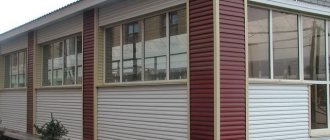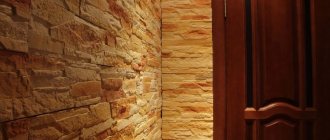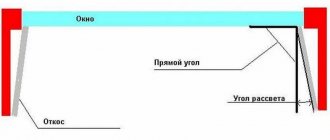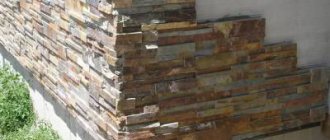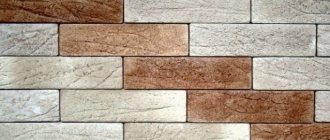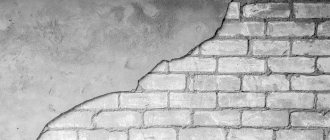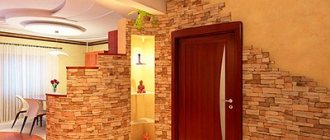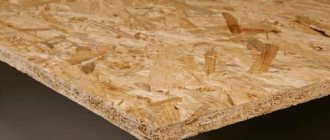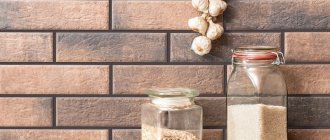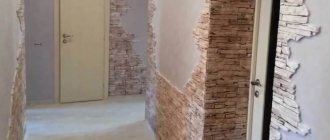Siding for interior wall decoration is a modern and quite attractive material that is easy to install with your own hands.
Materials for interior finishing should not be as durable as materials for exterior finishing of a building.
[contents]
Types of siding for interior work
You can find a large number of panels on sale, the scope of which is largely determined by the composition.
types of lamellas in construction are :
- Plastic. PVC, acrylic and vinyl are used as raw materials. The products are characterized by low thermal conductivity and resistance to dampness, which allows their installation in damp rooms. They do not tolerate high and low temperatures well.
- Wooden. Natural raw materials are popular due to the naturalness and warmth of the surface of the slats. They are made from solid wood or veneer glued to a base of chipboard or fiberboard. Finished products imitate timber, logs or boards. Can be used in dry rooms, such as a corridor, bedroom, hallway.
- Metal. The planks are made by pressing from steel with a thickness of 0.4-0.6 mm, followed by the application of a decorative and protective coating. The coating is durable, resistant to temperature changes and aggressive environments. It is rarely used in living rooms, more often - for utility rooms and industrial buildings - sheds, garages, workshops.
Wood
Plastic
Metal
The interior uses finishes that imitate wood, silicate and ceramic bricks, limestone, granite, cobblestone and facade plaster. 3D panels are very popular. The choice is made based on the design of the object and one’s own taste priorities.
Varieties and their characteristics
Siding consists of elements made of PVC or steel, which are fastened together with locks. Plastic material is available in the following options:
- ordinary, not shock-resistant;
- reinforced, in a stone design;
- steel
Steel panels are a very strong formed sheet that is used for exterior cladding or interior decoration of non-residential buildings. Metal siding is much more expensive, it lasts longer, but its use in the interior is impractical.
For interior decoration, analogues of siding are produced, materials that are more affordable and relevant in the interior: PVC and MDF panels, plastic and wooden lining.
Plastic panels are moisture-resistant, non-flammable, and are widely used in bathrooms, kitchens, hallways, and storage rooms. A huge plus is that they wash well and do not change color from exposure to light, dampness and detergents. The design options on the display case are not so varied, but manufacturers also offer other products that can be ordered. In this case, you will have to wait to get a more interesting design.
MDF panels and lining are afraid of dampness and cannot be used in bathrooms, toilets, or basements. Wooden lining, with special treatment, can cope with dampness, but this is impractical when you can simply use a material more suitable for the room, with the exception of a bathhouse.
Advice! When choosing between wall covering options, it is worth taking into account all types, calculating their cost, and drawing a project. In large construction stores, salespeople and designers will help you with this free of charge and with pleasure.
Application for interior decoration
While it’s not difficult to decide on color and texture, the choice of material for finishing a particular room needs to be approached more responsibly, carefully and thoughtfully.
The following criteria exist :
- Bathroom. The object is characterized by high humidity and a high probability of splashes and jets of water hitting the walls. Here it is better to use plastic coatings, without internal voids. Polymer slats have low thermal conductivity and are pleasant to the touch. They can be mounted on a steel frame, but it is more advisable to attach them with glue. There are no special requirements regarding color and texture.
- Kitchen. There is humidity and significant temperature changes here, but all of this is not on a critical scale. Therefore, you can use the panels zonally - metal at the work table, plastic opposite the stove and sink, and install wooden flooring in other places.
- Balcony and loggia. These are extreme places in every way. They are exposed to heat and cold, moisture, wind and ultraviolet radiation. Don't forget about birds and insects. The best solution would be vinyl that can withstand these factors. You can put steel slats on top. If the object is glazed and heated, there are no restrictions regarding finishing.
When deciding on the frame material, you need to take into account that even galvanized iron begins to rust over time, and wood deforms and rots.
Interior use
Let's consider special cases of using all siding options for interior decoration, with photos in the interior.
Classic siding
Classic, smooth siding with a wood-look design looks warm and cozy. The design is most suitable for the bedroom. This wall creates a calm background and is easier to maintain than natural wood.
Stone siding
Stone design in interior decoration looks very trendy, provided it is used correctly. It’s common to see it on balconies, in corridors, along the fireplace. An uninsulated balcony is a cold room; in winter, ordinary siding here is easily damaged. The use of reinforced panels will preserve the aesthetic appearance of the room for a long time.
Siding with imitation brick in the living room is an excellent option for modern interior decoration. This decor will cost less than natural decor, is installed much faster, does not require additional processing, and is easy to maintain.
Just like in the photo you can decorate a bedroom, office or kitchen. Non-combustible siding still requires additional protection near the slab in the form of fire-resistant glass.
Design for timber
Imitation of timber allows you to create the full feeling of being in a wooden house, and this is an unaffordable luxury for most. The desire for nature and naturalness is very important for modern interior decoration. Despite the myth about the harmfulness of plastic materials, siding in the interior is becoming increasingly popular; manufacturers confirm its non-toxicity and fire safety with appropriate certificates. Video instructions for installing siding
Metal siding
For the interior decoration of the garage, it is good to use metal siding. It is very durable and will last a long time in damp, chemically exposed conditions. The surface does not deteriorate when cleaned with harsh detergents. The garage design in the photo is stylish and discreet.
This siding is suitable for exterior and interior decoration of basements and utility rooms.
PVC panels
A more affordable analogue of siding is PVC panels. It looks simpler and is common as an economical option for interior decoration. But rooms with such walls look very neat and beautiful, and are easy to clean.
There are options with higher decorative qualities, as in the photo below. They create a feeling of luxury, more affordable than ceramic tiles, but more expensive than conventional PVC panels.
PVC panels create worthy competition for siding in interior decoration. For example, combining chocolate stripes and coffee with milk in the bedroom.
Or imitation stone in the corridor.
Or a cheerful wall in the living room - a bold solution perfectly replaces wallpaper. Wall covering will last longer without reducing its decorative qualities, especially important for a home with small children. A huge advantage is the easy cleaning of such a surface.
MDF panels
Adherents of natural materials choose MDF panels - they are used for interior decoration of rooms with normal humidity. The pattern imitates wood, but without relief.
The photo shows a successful combination of wall and ceiling made of the same material. Even a simple, inexpensive analogue of siding, if skillfully designed, can create a unique luxurious interior.
For comparison - the classic design of walls with MDF panels and ceilings with plastic. Clean, beautiful, bright, but without any zest, a hasty renovation. Even such work requires material costs no less than the previous option. It’s worth including a little personal imagination to create an interesting interior.
Lining
Wooden lining is used for home baths, saunas, decorating accent walls, and is relevant in the hallway. For interior decoration, the material is preferable because of its naturalness. It is produced in a form untreated with paints and varnishes, and can be painted in any color.
Plastic lining is more often used to decorate the ceiling; it takes longer to install on walls due to its narrow size. But if you want just such a design, you can work hard.
Advice! When choosing a room design, don’t be afraid to experiment. Personal ideas embodied in the interior are more pleasing, closer to the soul. I want to live and create in such a room.
How to choose siding
After determining the material, color and embossing option, you need to make calculations and make an estimate. A margin of up to 20% should be provided for trimmings and errors.
When purchasing, you need to pay attention to the following points :
- Manufacturer. It is better to take products from well-known and trusted brands and check for certificates.
- Completeness. Fasteners and additional parts are purchased along with the panels. It is advisable that they be of the same brand. This guarantees that they will fit in color and size.
- Product quality. This means no chips, cracks, scratches or bends. The packaging must indicate the brand, model and date of manufacture.
If the structure is temporary, it is better to go with a budget option. When it is calculated for many years, you should not focus on the price.
Installation technology
The panels are secured to a wooden sheathing. Metal lathing is used for the ceiling. Wooden elements must be dry (permissible humidity no more than 18%), pre-treated with antiseptic compounds, and free from obvious defects (knots, cracks).
PVC panels are fixed one after another to the sheathing with fasteners, preferably with self-tapping screws. In this case, there should be no gaps between the boards. If gaps cannot be avoided, use silicone sealant that matches the color of the panels. If the panels are larger than required, they can be easily trimmed using an electric jigsaw or hacksaw.
The costs of such cladding will be much lower than when using other finishing materials. Installing siding is a low-labor task, since there is no need to level the walls of the room.
Ceiling siding
Siding panels have proven themselves not only for interior wall decoration, but also for cladding ceiling surfaces. In general, installation of siding panels on the ceiling is carried out in the same way as on walls, but there are some peculiarities.
It is recommended to use panels measuring 25x300 cm. For high ceilings, it is advisable to use siding panels in darker shades, while low ceilings are recommended to be covered with light panels.
Selection of facade panels
In this section we will briefly describe all the advantages and disadvantages of siding made from various materials:
Vinyl panels
Positive traits:
- Lightweight - do not bear any load on the walls and foundation.
- Simple installation - when using siding up to 3 meters in length, you can handle the installation work alone.
- Hundreds of different colors.
- UV resistance: PVC panels do not lose their color for many years.
The disadvantages include:
- Fragility of the structure - any mechanical impact will lead to the surface being deformed. However, vinyl siding cannot be repaired.
- When installing panels on an uneven surface in the first winter, most of them will be damaged, since polyvinyl chloride becomes brittle in the cold and bursts under pressure.
Metal and aluminum products
Pros:
- They are durable and do not depend on temperature changes; they do not become more fragile in severe frost.
- They are not afraid of moisture, dirt and insects, and are not classified as materials susceptible to mold and mildew.
Minuses:
- Additional load on the foundation, which must be taken into account at the design stage.
- Facade panels freeze in the cold, creating additional “load” on the thermal insulation material.
- Cannot be repaired if dents or cracks appear.
Wood siding
There is no need to talk about environmental friendliness and quality of the product - log siding is an excellent option for lovers of natural materials, however, a couple of points should be noted that may negatively affect your choice:
- Wood requires care - once every 2-3 years it is necessary to treat it with special impregnations and products that provide protection from fire and insects.
- It is necessary to renew the paint on the surface, therefore, every 5-6 years (depending on the quality of the paint).
Expensive to maintain, but beautiful on the outside
Siding for balconies, loggias, baths
Inside the room, any walls can be covered with siding sheets: from the corridor to the balcony, as well as ceilings in rooms for any purpose.
Siding for balconies and loggias
When using siding panels to cover a balcony or loggia from the inside, you can use panels from any material. Vinyl systems are most often used.
When covering a balcony, you should keep in mind that siding is applied to a previously prepared sheathing .
The material of the sheathing depends on what the enclosing elements on the balcony are made of. The lathing is made from a metal profile on a metal base .
If a wooden sheathing system is being used, then all its elements must first be treated with antiseptic agents.
As a rule, when covering a balcony or loggia with siding sheets, an insulating layer is installed, which ensures good thermal insulation of the balcony or loggia room .
Thermal insulation, which is installed under the siding on a balcony or loggia, provides protection from cold air flows.
If the balcony does not need thermal insulation, insulation is not installed. However, due to the good ventilation of the panel system, they are not hermetically sealed against air passage.
Fastening sheets of siding to the balcony must be done with self-tapping screws, which are fastened strictly into the holes intended for fastening, and not into holes made independently in the panel.
The installation of panels for cladding balconies and loggias begins with the installation of a horizontal profile, which ensures the evenness of the continuous covering.
ATTENTION!
Panels for covering a loggia or balcony should be installed with a small gap (a few millimeters), since the balcony is a place of temperature changes that contribute to the expansion of the material.
Siding is actively used for cladding balconies and loggias due to its convenience, ease of installation, aesthetic appeal, and also fairly low cost.
And if the space under the siding is equipped with insulation, then it is possible to provide additional thermal protection to the room and significantly retain heat in cold weather .
Loggia siding
Bath siding
Siding coating is ideal for tiling work in the bathroom. The bathtub room has high humidity levels .
Panels, which are characterized by their ability to provide air ventilation and not retain drops of condensation, are installed both on the walls of bathrooms and on the ceiling.
Vinyl panels are ideal.
The property of the siding coating to be easy to clean and maintain stable resistance to moisture is another reason for installing it in the bathroom.
Unlike fastening siding on a balcony, where installation of panels does not require increased tightness of fit to each other, in the bathtub they should be installed with a fairly tight fit, followed by sealing the gaps .
In addition to a reliable coating, spotlights can be mounted in the panels, and communications can be hidden behind the coating.
Installation in the bathroom can be done on the lathing . In rare cases, it is performed by gluing panels to the wall.
Photo of bath siding

